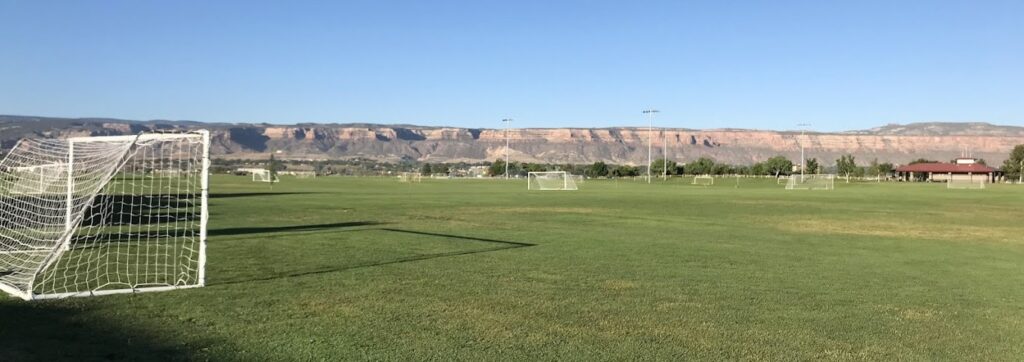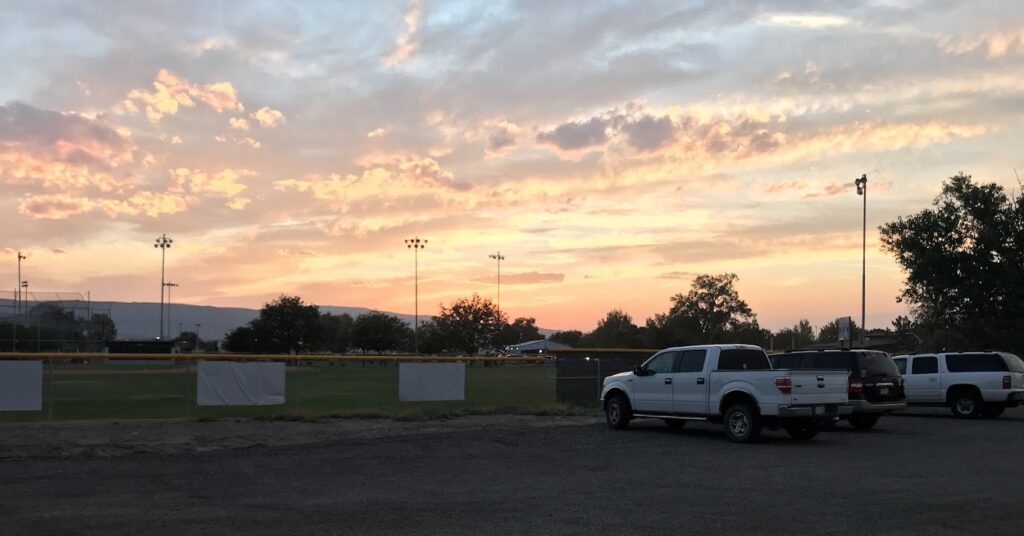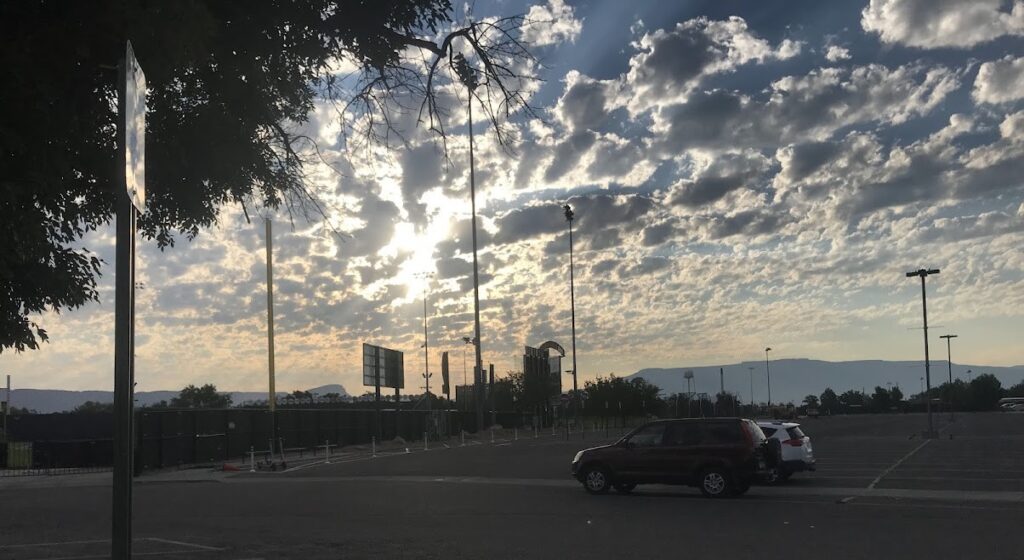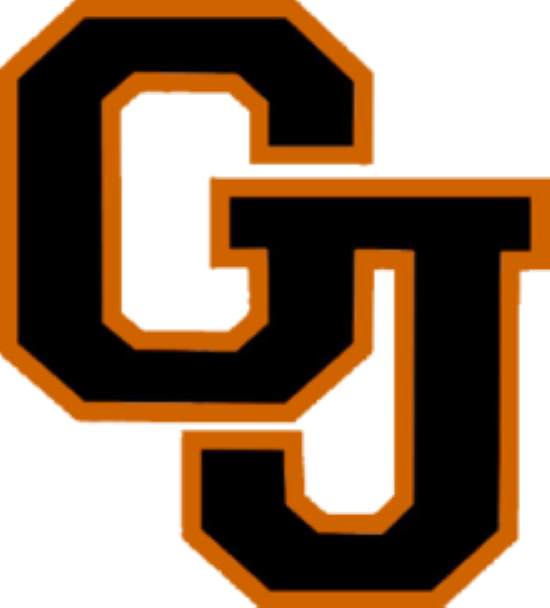Grand Junction, Colorado, is a city of just over 100,000 people located in the far western part of the state, just 26 miles from the Utah border.
We’re roughly halfway between Denver, and Salt Lake City, Utah.

In college, when I’d tell people where I’m front, they’d invariably, “Where is Grand Junction?” I’d reply, “In the middle of nowhere.”
And that’s sort of true.
Grand Junction is not rural Alaska or North Dakota remote, but if you look at one of those satellite night pictures, you’ll see a small glow of light along the Colorado/Utah border surrounded by a lot of darkness.
While there are no exact borders, Grand Junction can almost be considered in the American Southwest.
Grand Junction’s Location
Known for some breathtaking scenery, peaches, rafting, mountain biking, JUCO baseball, and Colorado’s wine country, Grand Junction sits at the confluence of the Colorado and Gunnison Rivers. The Colorado River used to be called the “Grand River,” back in the 1800’s, hence our name.
When going north/south in Colorado, the Grand Junction/Fruita/Palisade areas, (collectively known as the “Grand Valley”), is roughly in the middle of the state, lengthwise.
We’re not considered Northern Colorado (like Fort Collins or Greeley), but nor are we Southern Colorado either (i.e. Durango, or Pueblo). We’re simply Western Colorado.

Because Grand Junction is centrally located between the red rock canyons of Moab and the snow-capped peaks of Aspen, Vail and Telluride, we’re also known mostly as a gateway to a variety of tourist destinations in both the Colorado Rockies and Southeastern Utah.
If you’re flying into Colorado to ski, hunt, hike, bike, camp, fish or raft and you’re not landing at Denver International Airport, you’re likely flying into Grand Junction (or nearby Montrose).
Similarly, folks wanting to visit Arches National Park or Canyonlands National Park near Moab will find Grand Junction to be much closer than a drive from Salt Lake City.
Grand Junction’s Location and Geography
A New York Times article once described Grand Junction as “remote.” And when you look at it on a United States map, it seems that’s pretty fair to say.
Grand Junction is located in Mesa County, Colorado, which is 3,341 square miles in size, making the county larger than two states (Rhode Island and Connecticut).
The black star below marks the location of Grand Junction, Colorado
As the largest town in Mesa County, (and all of the Western Slope), Grand Junction is a major commercial/shopping/entertainment hub for those in Western Colorado and Eastern Utah.
Back in the day before Amazon and online shopping, shoppers from anywhere from Price, Utah to Meeker, Colorado would flock to Grand Junction for holiday shopping as we have the only shopping mall in the region.
The city of Grand Junction (along with surrounding areas of Clifton, Fruitvale, Orchard Mesa and The Redlands), sit roughly halfway between the towns of Fruita, Colorado and Palisade. It’s just about 15 to 20 minute drive from Fruita or Palisade when starting out in downtown Grand Junction.
Grand Junction, along with all of Colorado and neighboring Utah, is situated in the Mountain Time Zone.
Grand Junction, CO. Altitude
Grand Junction sits at an elevation of 4,593 feet and is surrounded by unique geological formations, including the Colorado National Monument, the Book Cliffs, and the Grand Mesa – the world’s largest flat-top mountain.
All this means is that we aren’t subject to tornados. And since we don’t get hurricanes, earthquakes, fires or major flooding, Grand Junction is one of the safest areas in the United States, in terms of our lack of natural disasters.
Being in the high desert, we have a very dry climate with less than 10 inches of precipitation a year.
Grand Junction Latitude and Longitude
The exact coordinates of Grand Junction are:
Latitude: 39.0639° N
Longitude: 108.5506° W
Technically, we’re classified as a semi-arid climate, which is characterized by hot summers, mild winters, and low humidity. We receive about 300 days of sunshine per year, none of which occur in January, from my experience.
Distances to Major Nearby Cities
Although we serve as regional hub for Western Colorado and Eastern Utah, if you’re going to take a road trip from Grand Junction, you’re going to be in the car for at least a little while.
Here are driving distances and times to some of the more popular places near Grand Junction:
- Denver, CO – 243 miles (391 km) east (4 hour drive)
- Salt Lake City, UT – 284 miles (457 km) northwest (4.5 hours)
- Colorado Springs, CO – 309 miles (497 km) southeast (5 hours)
- Albuquerque, NM – 412 miles (663 km) south (6 hours)
- Moab, UT – 113 miles (182 km) west (1.5 hours)
- Aspen, CO – 128 miles (206 km) east (2.5 hours)
- Telluride, CO – 124 miles southeast (Just under 2 and ½ hours)
The drive from Grand Junction to Moab is a pretty one, and takes about an hour and a half. If traveling to their world famous hot springs, a drive from Grand Junction to Glenwood Springs is just over an hour’s drive. Grand Junction to Vail and Beaver Creek is a tad over 2 hours.
These are driving times in good weather with dry roads, which may not always be the case from October to April.
Colorado’s Banana Belt
One of Grand Junction’s nicknames is the “banana belt,” due to our large banana crop.
Just kidding. But the area does get warmer than most other areas of the Centennial State.

When you picture Colorado, you typically think of snow-capped peaks, but despite our proximity to 14’ers (mountains that are 14,000 feet or higher in elevation), Grand Junction has a mild climate that is conducive for growing crops, like our famous peaches and grapes for wine-making.
How to Get to Grand Junction
By Car
- Interstate 70 runs through the north end of Grand Junction. On average, 21,000 cars drive through the I-70 Horizon Drive exit in Grand Junction per day, according to the Colorado Department of Transportation statistics. Of those 21,000 vehicles, half are ahead of me in the Horizon Drive Taco Bell drive-through, per personal observation.
- Highway 50, on the south end of the valley connects Grand Junction to Montrose, Telluride, Gunnison, and Pueblo. A lot of locals take this route as a pretty, sometimes faster alternative drive to Colorado Springs.
By Air
- Grand Junction Regional Airport (GJT) offers direct flights to Denver, Dallas, Phoenix, and Salt Lake City. There is also a direct flight to Las Vegas that leaves once or twice a week. (Related: Grand Junction Airport parking).
By Train
- Amtrak’s California Zephyr stops in Grand Junction, and is a safer, much more stress-free way to avoid ski traffic when going to Denver. The California Zephyr travels from Chicago to San Francisco.
Other
- Grand Junction is less than 200 miles (as the crow flies), from the Four Corners Monument, which marks the exact location of the meeting point for the borders of Colorado, New Mexico, Utah and Arizona.
- Many roads in Grand Junction are named after their respective distance from the Utah state line. 27 Road, for example, is 27 miles from the Utah border.
- I only know this because my son was studying antipodes in school, but the antipode (the exact opposite side of the Earth) for Grand Junction is a spot in the Indian Ocean.
(By Steve Beauregard. Photos copyright GJFruita.com)
